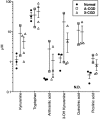Tryptophan/kynurenine metabolism in human leukocytes is independent of superoxide and is fully maintained in chronic granulomatous disease
- PMID: 20511543
- PMCID: PMC2947395
- DOI: 10.1182/blood-2009-07-233734
Tryptophan/kynurenine metabolism in human leukocytes is independent of superoxide and is fully maintained in chronic granulomatous disease
Abstract
In chronic granulomatous disease (CGD), defective phagocytic nicotinamide adenine dinucleotide phosphate (NADPH) oxidase activity causes reduced superoxide anion (O(2)(·)) radical production leading to frequent infections as well as granulomas and impaired wound healing indicative of excessive inflammation. Based on recent mouse studies, the lack of O(2)(·)-dependent interferon γ (IFNγ)-induced synthesis of kynurenine (kyn), an anti-inflammatory tryptophan metabolite produced by indolamine 2,3 deoxygenase (IDO), was proposed as a cause of hyperinflammation in CGD and this pathway has been considered for clinical intervention. Here, we show that IFNγ induces normal levels of kynurenine in cultures of O(2)(·)-deficient monocytes, dendritic cells, and polymorphonuclear leukocytes from gp91(PHOX)- or p47(PHOX)-deficient human CGD donors. Kynurenine accumulation was dose- and time-dependent as was that of a downstream metabolite, anthranilic acid. Furthermore, urinary and serum levels of kynurenine and a variety of other tryptophan metabolites were elevated rather than suppressed in CGD donors. Although we did not specifically evaluate kyn metabolism in local tissue or inflamed sites in humans, our data demonstrates that O(2)(·) anion is dispensable for the rate-limiting step in tryptophan degradation, and CGD patients do not appear to have either hematopoietic cell or systemic deficits in the production of the anti-inflammatory kynurenine molecule.
Figures






Similar articles
-
Defective tryptophan catabolism underlies inflammation in mouse chronic granulomatous disease.Nature. 2008 Jan 10;451(7175):211-5. doi: 10.1038/nature06471. Nature. 2008. PMID: 18185592
-
Intact indoleamine 2,3-dioxygenase activity in human chronic granulomatous disease.Clin Immunol. 2010 Oct;137(1):1-4. doi: 10.1016/j.clim.2010.05.007. Epub 2010 Jun 8. Clin Immunol. 2010. PMID: 20570568 Free PMC article.
-
Four novel mutations in the gene encoding gp91-phox of human NADPH oxidase: consequences for oxidase assembly.Blood. 2000 Jan 15;95(2):666-73. Blood. 2000. PMID: 10627478
-
Hematologically important mutations: X-linked chronic granulomatous disease (third update).Blood Cells Mol Dis. 2010 Oct 15;45(3):246-65. doi: 10.1016/j.bcmd.2010.07.012. Epub 2010 Aug 21. Blood Cells Mol Dis. 2010. PMID: 20729109 Free PMC article. Review.
-
Inflammation and repeated infections in CGD: two sides of a coin.Cell Mol Life Sci. 2012 Jan;69(1):7-15. doi: 10.1007/s00018-011-0834-z. Epub 2011 Nov 15. Cell Mol Life Sci. 2012. PMID: 22083605 Free PMC article. Review.
Cited by
-
Major CD4 T-Cell Depletion and Immune Senescence in a Patient with Chronic Granulomatous Disease.Front Immunol. 2017 May 11;8:543. doi: 10.3389/fimmu.2017.00543. eCollection 2017. Front Immunol. 2017. PMID: 28553289 Free PMC article.
-
Role of brain transmigrating neutrophils in depression-like behavior during systemic infection.Mol Psychiatry. 2014 May;19(5):599-606. doi: 10.1038/mp.2013.137. Epub 2013 Oct 15. Mol Psychiatry. 2014. PMID: 24126927
-
Genetic disorders coupled to ROS deficiency.Redox Biol. 2015 Dec;6:135-156. doi: 10.1016/j.redox.2015.07.009. Epub 2015 Jul 17. Redox Biol. 2015. PMID: 26210446 Free PMC article. Review.
-
From Flies to Men: ROS and the NADPH Oxidase in Phagocytes.Front Cell Dev Biol. 2021 Mar 26;9:628991. doi: 10.3389/fcell.2021.628991. eCollection 2021. Front Cell Dev Biol. 2021. PMID: 33842458 Free PMC article. Review.
-
Regulation of innate immunity by NADPH oxidase.Free Radic Biol Med. 2012 Jul 1;53(1):72-80. doi: 10.1016/j.freeradbiomed.2012.04.022. Epub 2012 May 1. Free Radic Biol Med. 2012. PMID: 22583699 Free PMC article. Review.
References
-
- Segal BH, Leto TL, Gallin JI, Malech HL, Holland SM. Genetic, biochemical, and clinical features of chronic granulomatous disease. Medicine (Baltimore) 2000;79(3):170–200. - PubMed
-
- Lekstrom-Himes JA, Kuhns DB, Alvord WG, Gallin JI. Inhibition of human neutrophil IL-8 production by hydrogen peroxide and dysregulation in chronic granulomatous disease. J Immunol. 2005;174(1):411–417. - PubMed
-
- Brown JR, Goldblatt D, Buddle J, Morton L, Thrasher AJ. Diminished production of anti-inflammatory mediators during neutrophil apoptosis and macrophage phagocytosis in chronic granulomatous disease (CGD). J Leukoc Biol. 2003;73(5):591–599. - PubMed
-
- Henderson WR, Klebanoff SJ. Leukotriene production and inactivation by normal, chronic granulomatous disease and myeloperoxidase-deficient neutrophils. J Biol Chem. 1983;258(22):13522–13527. - PubMed
Publication types
MeSH terms
Substances
Grants and funding
LinkOut - more resources
Full Text Sources
Research Materials
Miscellaneous

